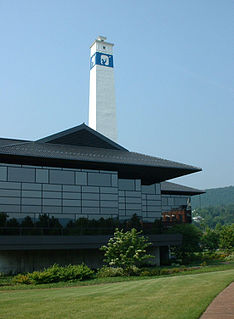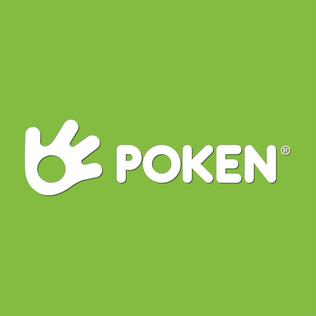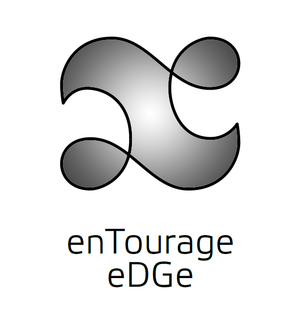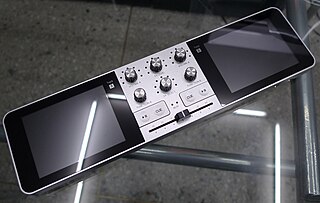
A liquid-crystal display (LCD) is a flat-panel display or other electronically modulated optical device that uses the light-modulating properties of liquid crystals combined with polarizers. Liquid crystals do not emit light directly, instead using a backlight or reflector to produce images in color or monochrome. LCDs are available to display arbitrary images or fixed images with low information content, which can be displayed or hidden, such as preset words, digits, and seven-segment displays, as in a digital clock. They use the same basic technology, except that arbitrary images are made from a matrix of small pixels, while other displays have larger elements. LCDs can either be normally on (positive) or off (negative), depending on the polarizer arrangement. For example, a character positive LCD with a backlight will have black lettering on a background that is the color of the backlight, and a character negative LCD will have a black background with the letters being of the same color as the backlight. Optical filters are added to white on blue LCDs to give them their characteristic appearance.
A plasma display panel (PDP) is a type of flat panel display that uses small cells containing plasma: ionized gas that responds to electric fields. Plasma TVs were the first large flat panel displays to be released to the public.
VAIO Corporation is a Japanese manufacturer headquartered in Azumino, Nagano Prefecture that makes personal computers and smartphones.

Corning Incorporated is an American multinational technology company that specializes in specialty glass, ceramics, and related materials and technologies including advanced optics, primarily for industrial and scientific applications. The company was named Corning Glass Works until 1989. Corning divested its consumer product lines in 1998 by selling the Corning Consumer Products Company subsidiary to Borden, but still holds an interest of about 8 percent.

A gadget is a mechanical device or any ingenious article. Gadgets are sometimes referred to as gizmos.

A touchscreen or touch screen is the assembly of both an input and output ('display') device. The touch panel is normally layered on the top of an electronic visual display of an information processing system. The display is often an LCD or OLED display while the system is usually a laptop, tablet, or smartphone. A user can give input or control the information processing system through simple or multi-touch gestures by touching the screen with a special stylus or one or more fingers. Some touchscreens use ordinary or specially coated gloves to work while others may only work using a special stylus or pen. The user can use the touchscreen to react to what is displayed and, if the software allows, to control how it is displayed; for example, zooming to increase the text size.
Planar Systems, Inc. is a premiere digital display manufacturing corporation with a facility in Hillsboro, Oregon. Founded in 1983 as a spin-off from Tektronix, it was the first U.S. manufacturer of electroluminescent (EL) digital displays. Planar currently makes a variety of other specialty displays. Planar Systems, Inc. is a subsidiary of Leyard Optoelectronic Co. since 2015.

AlityPC is a Hong Kong technology company that designs and develops technology products for the home. Their products include digital photo frames and high-tech lifestyle gadgets.
UltraPin is a Multi-Game pinball arcade game that holds 12 digital recreations of Williams Electronics real pinball games in a single pinball cabinet. UltraPin is built in a traditional style pinball cabinet to look and feel like a real pinball machine. It has two LCD screens, a 19 inch LCD for the back glass and DMD, and a 32 inch LCD for the playfield, and it uses Windows XP Embedded for its operating system.

In computing, multi-touch is technology that enables a surface to recognize the presence of more than one point of contact with the surface at the same time. The origins of multitouch began at CERN, MIT, University of Toronto, Carnegie Mellon University and Bell Labs in the 1970s. CERN started using multi-touch screens as early as 1976 for the controls of the Super Proton Synchrotron. Capacitive multi-touch displays were popularized by Apple's iPhone in 2007. Plural-point awareness may be used to implement additional functionality, such as pinch to zoom or to activate certain subroutines attached to predefined gestures.

Microsoft PixelSense is an interactive surface computing platform that allows one or more people to use and touch real-world objects, and share digital content at the same time. The PixelSense platform consists of software and hardware products that combine vision based multitouch PC hardware, 360-degree multiuser application design, and Windows software to create a natural user interface (NUI).

The OLPC XO, previously known as the $100 Laptop, Children's Machine, and 2B1, is an inexpensive laptop computer intended to be distributed to children in developing countries around the world, to provide them with access to knowledge, and opportunities to "explore, experiment and express themselves". The XO was developed by Nicholas Negroponte, a co-founder of MIT's Media Lab, and designed by Yves Behar's Fuseproject company. The laptop is manufactured by Quanta Computer and developed by One Laptop per Child (OLPC), a non-profit 501(c)(3) organization.

Poken is a cloud-based event management platform, utilized by trade shows and exhibitions, corporate and association events, as well as sports and youth events. The modular platform includes features and services such as registration and badging, match-making, meeting scheduling, mobile apps, NFC interactive USB devices, lead generation devices, gamification, access control and metrics reporting.
In electrical engineering, capacitive sensing is a technology, based on capacitive coupling, that can detect and measure anything that is conductive or has a dielectric different from air. Many types of sensors use capacitive sensing, including sensors to detect and measure proximity, pressure, position and displacement, force, humidity, fluid level, and acceleration. Human interface devices based on capacitive sensing, such as trackpads, can replace the computer mouse. Digital audio players, mobile phones, and tablet computers use capacitive sensing touchscreens as input devices. Capacitive sensors can also replace mechanical buttons.

The enTourage eDGe is a dual-panel personal device, combining a tablet computer on one screen and an e-book reader on the other. Since 2011 it has been developed by Pleiades Publishing, Ltd. The device runs Google's Android OS. At present Foxconn is engaged in mass manufacturing of the enTourage eDGe v2.5. Production volume is growing in line with demand, and the device is being geared to the high requirements for modern tablets.
IPS is a screen technology for liquid-crystal displays (LCDs). It was designed to solve the main limitations of the twisted nematic field effect (TN) matrix LCDs which were prevalent in the late 1980s. These limitations included strong viewing angle dependence and low-quality color reproduction. In-plane switching involves arranging and switching the orientation of the molecules of the liquid crystal (LC) layer between the glass substrates. This is done, essentially, parallel to these glass plates.

Zytronic is a manufacturer and developer of touch technology products based in Blaydon upon Tyne, United Kingdom.
A see-through display or transparent display is an electronic display that allows the user to see what is shown on the screen while still being able to see through it. The main applications of this type of display are in head-up displays, augmented reality systems, digital signage, and general large-scale spatial light modulation. They should be distinguished from image-combination systems which achieve visually similar effects by optically combining multiple images in the field of view. Transparent displays embed the active matrix of the display in the field of view, which generally allows them to be more compact than combination-based systems.

The Monster Go-DJ is a standalone portable DJ mixing unit from Monster Group.
FlexEnable Ltd is a technology provider that develops flexible organic electronics technologies and OTFT materials. The company launched in 2015, and is located on the Cambridge Science Park, just north of Cambridge city centre. It has more than 1,000 patents covering processes, designs and materials.













